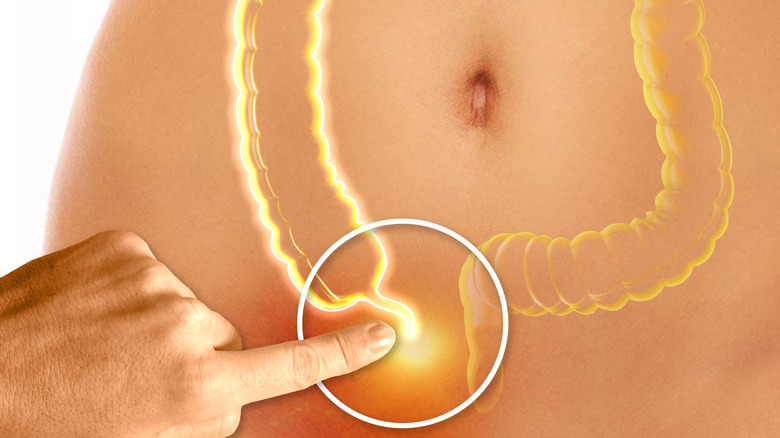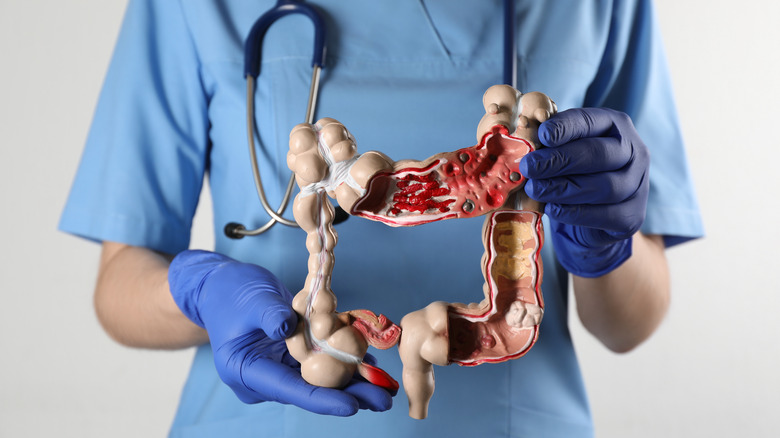Warning Signs From Your Appendix That You Shouldn't Ignore
The ambiguous appendix has always held an air of mystery. Its purpose is a conundrum, and we only ever seem to hear about it when it causes problems and needs to be removed — and stat. The appendix lives where the small intestine and large intestine meet in the lower right quadrant of your belly. It is shaped like a finger and is about 3.5 inches in length, per Kauvery Hospital. The location of the appendix is known as the McBurney's point by physicians (via Everyday Health)
Whether or not we need this tiny appendage is up for debate, and has been for quite some time. Some theories speculate it helps populate beneficial gut bacteria when needed, lending to the diversity of our microbiome. Others posit it plays a role in our immune system function and possibly aids in cell development during the fetal stage. While there is no general consensus as to its purpose, most medical professionals agree evolution will render the appendix obsolete (via Britannica).
When it's smooth sailing for the little enigmatic organ, we don't pay much attention to it or remember we even have one. However, when it's not happy and becomes infected, it can lead to a whole host of issues and can even be life-threatening. What are the warning signs from our appendix we shouldn't ignore?
Appendicitis defined and its dangers
Appendicitis is usually caused by a blockage of the appendix that leads to an infection, per the Mayo Clinic. The organ can become inflamed and full of pus — and it's very painful when this happens. If the infection is not addressed, the appendix can rupture and cause an onslaught of dangerous complications.
A ruptured appendix results if it's infected and not surgically removed quickly enough, approximately within 48 to 72 hours after symptoms begin, so knowing what symptoms to look out for is paramount. If a ruptured appendix is not treated, the infection can spread throughout the body and lead to sepsis, per iCare ER & Urgent Care.
While there are some typical signs to heed warnings from, it's important to note there is no standard manner in which the symptoms present in patients — once again, this little organ is confusing! All or one of the common symptoms may be present, and the order in which they occur varies. But it would behoove you to pay attention if any pop up.
Causes and risk factors for appendicitis
Appendicitis occurs when the appendix becomes infected with bacteria. There are a few causes of appendicitis. The most likely cause is a blockage in the lining of the appendix, typically from stool, that leads to an infection. The blockage cuts off blood flow, which allows bacteria to build up and pus to form. The blockage may also result from an infection somewhere else in the body, as the appendix may become larger in response to any infection. If not treated, the appendix can rupture (via Ada). The infection may also be caused by viruses, bacteria, or parasites found in your digestive tract, explains Stanford Medicine Children's Health. Occasionally, a tumor or cancer may cause the blockage. According to a clinical review published in the BMJ in 2006, in addition to obstruction, diet and heredity are believed to be possible factors as well.
Per WebMD, one in 20 people will develop appendicitis at some point. Onset is typically between the ages of 10 and 30, though it can happen at any age. A family history of appendicitis can increase your risk.
Abdominal pain is the cardinal symptom
By far, the most common warning sign of an infected appendix is abdominal pain. The pain usually originates near the navel and travels to the lower right quadrant of the abdomen. It may feel like a stomach ache at first, but eventually ends up as a dull, throbbing, and painful tenderness on your lower right side, according to the Cleveland Clinic. If that pain endures for six to 12 hours, appendicitis is the likely cause.
What differentiates appendicitis from other stomach pains is that it is persistent and progresses in severity. Typically, the pain does not come and go, and it usually feels much worse than any other stomach pain you've had before. It has a sudden onset and gets worse when you move or cough, explains the University of Maryland Medical System.
While the subsequent list of warning signs and symptoms associated with appendicitis vary from person to person, they all have a rapid onset and surface anywhere from four to 48 hours after the initial pain.
Nausea, vomiting, and appetite loss are common early warning signs
Appetite loss is an important symptom of appendicitis, per an analysis published in Medical Science in 2020. The study found that the accuracy of a loss of appetite as a diagnostic symptom of appendicitis was 91.25%, making it a telltale symptom. The study found that it often precedes the abdominal pain and vomiting associated with appendicitis. Though loss of appetite is present in most cases, occasionally patients do experience hunger. Therefore, it's not a cut-and-dried indication, according to the Nelson Textbook of Pediatrics.
In more than half of all appendicitis patients, nausea and vomiting arise within several hours of the onset of abdominal pain. As the infection progresses, mucus begins to fill the intestinal area cut off by the obstruction. The bacteria present start to proliferate very quickly and the abdomen swells, which leads to nausea and vomiting, according to Clinical Approach in the Diagnosis of Acute Appendicitis. According to a clinical review published in the BMJ in 2006, excessive vomiting may also indicate inflammation in abdominal tissue after a perforation has occurred. Patients with appendicitis also commonly have a dry tongue and bad breath, per the study.
While loss of appetite, nausea, and vomiting go hand-in-hand with many illnesses and stomach bugs, when accompanied by intense and progressive abdominal pain, these symptoms can indicate that it's time to get to the emergency room, per HCA Midwest Health.
Problems with bowel movements and urination may indicate an issue
Whether it's diarrhea or constipation, changes to your bowel movements often accompany appendicitis, per Johns Hopkins Medicine. If you notice large amounts of mucus in your diarrhea for more than two or three days, it's also a clue that you're facing an issue greater than just an upset tummy, according to Narayana Health.
Difficulty passing gas — especially painful gas — goes hand-in-hand with these bowel disturbances, per Healthline. Gas trapped by a blockage often causes uncomfortable bloating and indigestion, per MyMed.com. A revealing sign that it may be more than just a little flatulence is if the pressure in your abdomen lasts more ever becomes intolerable.
It's also common to experience painful urination with appendicitis, which may be attributed to pressure from inflamed abdominal tissue, per the Nelson Textbook of Pediatrics. If this is one of your symptoms, your physician may order a urine test to rule out a urinary tract or bladder infection, according to the National Health Service (NHS).
Fever and chills are also potential cues
A fever is never an illness in and of itself. It's commonly a sign that your body is fighting off an infection and is working hard to kill a virus or bacteria. An elevated internal body temperature makes it much harder for the invaders to survive, and it also prompts your immune system to get to battle, according to MedlinePlus.
In the case of appendicitis, if you have a fever and it is accompanied by chills and other telling symptoms like abdominal pain, there's a chance your appendix may have burst and it's time to hightail it to the hospital. A burst appendix requires emergency surgery, as it can lead to infection in the blood and be fatal. A fever with temperature of 99-102 degrees Fahrenheit often accompanies appendicitis, per WebMD. If the infection of the appendix isn't treated, it can spread to the rest of the abdomen, resulting in a fever and chills (via Cedars Sinai).
Treatment of appendicitis is straightforward
The most common treatment once a doctor determines you have appendicitis is emergency surgery to remove your appendix, otherwise known as an appendectomy. If an abscess is present, the first line of defense is antibiotics to handle the infection and swelling prior to surgery, per Mount Sinai. The reason surgery is the typical go-to treatment is because the bacteria can leak and spread to your entire abdomen, which can be life-threatening.
There are two methods for removing the appendix, per Johns Hopkins Medicine. Historically, cutting into the abdomen, known as an open surgery, was the go-to method. The organ is removed through a small incision around two to four inches, and you're left with a small scar on your lower right abdomen. A newer method gaining in popularity is a laparoscopic procedure. Much smaller incisions are made, about half the size of those made in open surgery. A tube with a tina camera attached is inserted into the abdomen via the incisions and the surgeon cuts the appendix out and removes it through the tube.
The laparoscopic method is much less invasive and leaves a smaller scar. However, if the appendix has ruptured or any other complications are noted, an open surgery will most likely be needed. Intravenous antibiotics alone may be the future treatment for appendicitis, but for now surgery is the typical option.
Conditions that can be mistaken for appendix pain
The most common symptom that gets mistaken for an infected appendix is, unsurprisingly, a stomach ache. Any upset tummy that causes nausea, vomiting, changes in bowel movements, or pain is easily assumed to be caused by the worst-case scenario — appendicitis. Any disease that affects the bowels is also a suspect, such as irritable bowel syndrome and Crohn's disease. Even a urinary tract infection may present with similar symptoms to appendicitis (via NHS).
Gallbladder issues, diverticulitis, ulcerative colitis, and just plain old gastritis all have similar symptoms and can be mistaken for appendix pain, per Ada. Constipation and a pelvic infection also have comparable symptoms. Per Doubts, Problems and Certainties about Acute Appendicitis, kidney stones or kidney infection may mimic appendicitis. Gynecological conditions in women such as ectopic pregnancy, twisted ovaries, ovarian cysts, and mid-cycle ovulation pain may also present similarly to appendix pain.
While an upset stomach from something you ate is best-case scenario, a thorough examination by a medical professional is necessary to rule out any other potential causes of persistent pain plus any of the accompanying symptoms.









